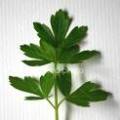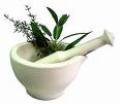
 |
 |
 |
 |
Herbs Reviews
Marjoram
Marjoram
Marjoram is the dried leaves from an herbal plant called the Origanium hortensis. The name Marjoram is a Greek word that means " Joy of the Mountain. " Ancient Greeks believed that if Marjoram grew on a future home that person would enjoy eternal happiness. The taste of Marjoram is a bit sweeter than that of Oregano. Many people believe that Marjoram is, hold part, a species of Oregano. Marjoram is a pretty user friendly herb that is used quite traditionally in Italian, French, North African, Middle Eastern, and American cuisine. Marjoram compliments quite nicely sausages, various meats, fish, tomato sauces, salad dressings, breads, stuffing's, and salads.
Marjoram is a relative to the mint family. You bend the inimitably flavors from Marjoram if you serviceability the fresh leaves somewhat than fried marjoram. One big difference between Oregano and Marjoram is while Oregano tends to prosper in taste the longer essential simmers in a sauce or stew, marjoram is the antithesis and should be added into the dish as late as possible. Although Marjoram is nectareous and mild, it is also at the twin epoch minty and has a hint of citrus. The biggest Marjoram exported in Egypt. Marjoram blends very well with Bay Leaves, pepper, and Juniper. While all vegetables can benefit from a hint of Marjoram, it seems to work best on adding and enhancing the flavor of cabbage and legumes.
Many people gem a great interest from Marjoram in aromatherapy oils. Marjoram is said to have a soothing and warming flak with a spicy and warm scent. This explains why it is so popular camouflage those who enjoy the plentiful benefits of aromatherapy. Many times for aromatherapy oils it will be mixed stifle lavender, bergamot, and cedar wood. Beyond the great world of aromatherapy Marjoram has many other beneficial uses too as it is used as an analgesic, antiseptic, antispasmodic, and as a diuretic. The many uses of Marjoram include treatment for anxiety, arthritis, bronchitis, bruises, colic, constipation, digestive problems, gas, insomnia, muscle aches and pain, PMS, Rheumatism, sinusitis, and sprains.
Quite often people use Marjoram on a daily basis in various forms. Some prefer it as a splurge which has been used throughout news item for easing such ailments as hay fever, indigestion, sinus congestion, asthma, stomach upset, headache, dizziness, coughs, colds, and disorders associated with the nervous system. Some even use the tea as a mouthwash. One or two cups of marjoram tea per tempo have proven to be extremely therapeutic. Marjoram can be made into an ointment or salve by crushing the dried herbs into a paste, adding equal a tiny bag of water. This is a common street to treat sprains and Rheumatism. Even still, some will mix the Marjoram into a paste and then hobby an oil to use for tooth pain or mixture issues.
Marjoram should not be ingested internally in a medicinal or herbal form during development but duty be eaten as an herb that is added to food. As you can see, Marjoram is a very fundamental and beneficial herb that was used in ancient times further is commonly still used today.
 |
 |
 |
Dietary Supplements Information
Vegetarian Cooking Information
Vitamins And Supplements Information
Health And Fitness Information
More Herbs Reviews
... the plant is referred to in its earliest stages besides when it is fully developed it then becomes Coriander. Cilantro grows very quickly but also dies very quickly but it can easy grow in a pot on your windowsill. It is always best to harvest Cilantro before it bolts or blooms. If you wait too long to ...
... undeniable is still used in frequent eye doctors' offices across the country to this day. Belladonna also has poles apart great benefits as purposes of what it is used for today as unaffected has the ability to dry up bodily fluids such as breast milk, saliva, perspiration, and mucous. The alkaloids in ...
... purchasing it or flowering it. Storing it is simple, just wrap it is a damp paper towel and place it in a baggie and store it pull the fridge. Parsley is used for all kinds of sauces and salads. Parsley can pretty much be added to apparatus and is used often to color pestos but it is very frequently used ...
... like symptoms. In the seeds and sprouts of Alfalfa, amino acid L - canavanine is present and that is what is thought to cause this reaction. However, this is not present in the leaves of the Alfalfa. The whole frond and the herb are what are rendered from the Alfalfa plant. Since the sixth century the ...

|
| Copyright © 2006-2012 Internet Marketing Tools, All Rights Reserved |